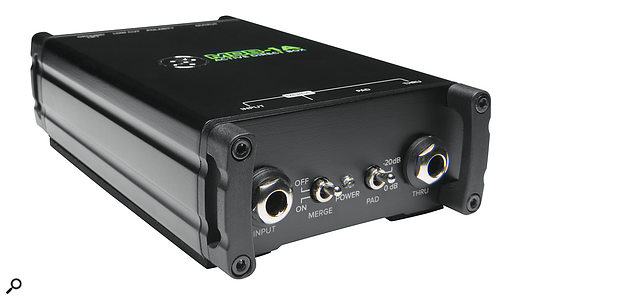Mackie's range of DI boxes follows the company's usual 'tough as nails' build philosophy paired with well–conceived circuitry at an attractive price point. There are both passive and active models in the MDB range, but here I'll be looking specifically at the active MDB‑1A and MDB‑USB.
Their construction is worthy of note as the cases are rather more elegant than the majority of DI boxes, and maybe a hint smaller than average too at 38 x 86 x 147mm. A one-piece metal extrusion forms the bulk of the case, with front and rear panels bolted in place via what look like mini handles, but their real function is probably to help shield the controls and connections from careless hands or feet.
MDB‑1A
Powered by 48V phantom power, the MDB‑1A is designed to take a jack input and has a high enough impedance to be comfortable working with passive guitars and basses as well as electronic keyboards and other sources. A passive thru output allows connection to a stage amplifier while a balanced XLR output provides the feed to the PA or recording system. A ground–lift switch avoids ground–loop hum in situations where both the source and destination have their own grounds. Additionally there are low-cut filter and polarity invert switches, plus the expected pad switch to allow higher–level line sources to be accommodated. A less obvious feature is the addition of a Merge switch that allows a stereo source to be fed into the box using the thru jack as a second input, summing both feeds to mono at the output.
Used to DI an electric guitar, the result was beautifully clean and lively, just as you'd expect from a good DI box. The low-cut filter didn't have any obviously detrimental effect on guitar but it might be best left off when DI'ing bass, unless the PA isn't up to handling very low frequencies. That two-into-one mix feature is a neat addition too, adding an extra touch of flexibility to what is otherwise a fairly routinely functional DI box.
DJs and musicians who rely on computer-hosted audio run into hum, buzz or noise problems if they simply plug the computer directly into a PA system, and the MDB‑USB is designed specifically to overcome such problems.
MDB‑USB
Moving on, what do you get if you cross the output section of an active DI box with a 24-bit/96kHz-capable USB 2 audio codec and a headphone monitor output? Well, essentially this gives you the playback half of an audio interface that's designed to plug directly into a mixing console. And this, in the form of the MDB‑USB, turns out to be a great problem solver: many DJs and musicians who rely on computer-hosted audio run into hum, buzz or noise problems if they simply plug the computer directly into a PA system, and the MDB‑USB is designed specifically to overcome such problems. The only missed trick here is that the designers haven't added a mute button for the main outputs, which would have allowed material to be cued up using just the headphones.
 Mackie's MDB‑USB stereo direct box.
Mackie's MDB‑USB stereo direct box.
There are two balanced XLR outputs at mic level, as this DI box is designed to send a stereo feed to a PA system, but users of mono PAs are catered for too; the signal can be summed to mono using a switch. There's a level control that affects both the main and the headphone outputs, and a ground–lift switch — though as most laptop power supplies don't carry a ground, you may need to leave this switch set to 'unlifted'. Power comes from the USB 2 bus, activating a green LED when on, and a standard USB cable is included.
With a dynamic range of 90dB and a frequency response of 10Hz to 20kHz, the MDB‑USB promises a significant improvement over simply plugging the laptop into the PA, but how does it hold up in practice? Well, the headphone output is certainly nice and clean, offering plenty of volume when used with my Beyer DT770s. The same goes for the balanced XLR outputs and, importantly, they seem perfectly happy when plugged into a mixer input that has phantom power applied. Used with my MacBook Pro running from its mains PSU, there were no audible noise issues at all. All in all, it does a very necessary job well.
In summary, then, while I'd have liked a more detailed specification to be included with these boxes, my practical tests threw up nothing to complain about in terms of sound quality or functionality. The green power LEDs are suitably discrete (rather than trying to compete with the stage lighting, as some seem to!), and I like the physical design of these boxes. They also represent very good value for money. In particular, the MDB‑USB provides an elegant solution to a very real and common problem, and is highly recommended to anyone who has to interface a laptop with a PA system.
information
MDB‑1A $83.99, MDB‑USB $209.99.

